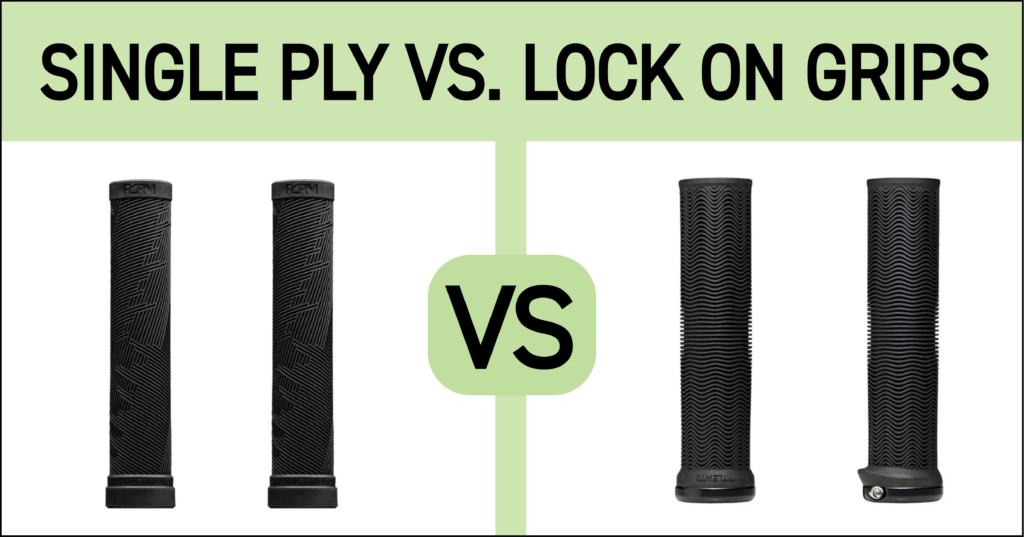Lock-On Grips vs. Single-Ply Grips: Choosing the right grips is essential for control, comfort, and performance in mountain biking. Two of the most common types of grips are lock-on grips and single-ply grips (also known as slide-on grips). Both have their strengths and weaknesses, and the best choice for you depends on your riding style, preferences, and conditions. Let’s break down the differences between lock-on and single-ply grips to help you decide which is right for your bike.
Lock-On Grips
What Are They?
Lock-on grips feature a hard plastic or metal core with collars at the ends that clamp to the handlebars using small bolts. This ensures that the grips stay securely in place, preventing any slipping or rotation during your ride.
Pros of Lock-On Grips:
- No Slipping: The biggest advantage of lock-on grips is that they don’t slip or twist on the bars, even in wet or muddy conditions. The locking mechanism keeps them firmly in place.
- Easy Installation and Removal: Lock-on grips are easy to install or remove using just a few small bolts. This makes it simple to replace them without using adhesives or lubricants.
- Durable: Lock-on grips tend to be more durable due to their solid inner core, especially for aggressive riding and tough terrain.
- Variety of Styles: Lock-on grips come in a wide range of designs, with different patterns and levels of cushioning, making it easy to find a set that fits your preferences.
Cons of Lock-On Grips:
- Heavier: Due to the locking mechanism and solid core, lock-on grips are typically heavier than single-ply grips.
- More Expensive: Lock-on grips are generally more expensive due to their construction and added hardware.
- Less Cushioning: The solid inner core can limit the amount of cushioning provided by the grip, which may lead to more hand fatigue for some riders.
Best For:
- Riders who prioritize secure grip and easy installation.
- Aggressive riders, downhillers, or those riding in wet or muddy conditions where grip slippage could be an issue.
Single-Ply Grips
What Are They?
Single-ply grips are made from a single layer of rubber or foam that slides directly onto the handlebar. They don’t have a locking mechanism, relying on friction or adhesive to stay in place.
Pros of Single-Ply Grips:
- Lightweight: Without the locking hardware, single-ply grips are lighter, making them a popular choice for riders focused on minimizing bike weight.
- More Cushioned: Single-ply grips typically offer more cushioning and comfort because of their softer construction, making them ideal for long rides or riders who suffer from hand fatigue.
- Less Expensive: These grips are usually more affordable compared to lock-ons, making them a budget-friendly option.
- Better Vibration Dampening: The soft, pliable rubber or foam can absorb more vibration, improving comfort on rough terrain.
Cons of Single-Ply Grips:
- Prone to Slipping: The biggest downside is that single-ply grips can slip or rotate on the handlebars, especially in wet or muddy conditions. This can affect control and performance.
- More Difficult Installation: Single-ply grips often require the use of adhesive, hairspray, or isopropyl alcohol to install, which can make the process trickier. Removing them can also be more difficult.
- Less Durable: Single-ply grips are generally less durable than lock-ons, especially if they are frequently exposed to harsh conditions or aggressive riding.
Best For:
- Riders seeking lightweight grips and extra comfort.
- Cross-country riders or those on smoother trails where grip slipping is less likely to occur.
Key Considerations
- Riding Style:
- If you ride aggressive, technical terrain or downhill, lock-on grips are better because they stay securely in place.
- For riders focused on lightweight builds and long-distance comfort, single-ply grips may be the better option.
- Weather Conditions:
- In wet or muddy conditions, lock-on grips are a safer choice as they won’t slip.
- In dry, mild conditions, single-ply grips should hold up well and offer a cushier ride.
- Hand Comfort:
- If you prioritize comfort and vibration absorption, single-ply grips tend to offer a softer, cushioned feel.
- If security and control are more important, lock-on grips are the better choice, even if they sacrifice some cushioning.
- Ease of Use:
- Lock-on grips are easier to install and remove, while single-ply grips may require more effort and the use of adhesive or lubricant during installation.
Conclusion
Both lock-on and single-ply grips have their advantages, and the best choice depends on your specific needs. Lock-on grips offer secure attachment and easy installation, making them ideal for aggressive riding, while single-ply grips are lighter and provide more cushioning, making them better for cross-country or riders who prioritize comfort. Evaluate your riding conditions, comfort needs, and budget to decide which grip type will enhance your riding experience the most.
Remember that we offer free shipping on all orders over $149CAD. Orders are all processed and shipped within 24 business hours as well. Looking for mountain bike parts? We stock hundreds of parts from multiple brands and you can shop our entire selection here.
Spend less and ride the best with TBS Bike Parts.
Related Articles
2 PISTON VS. 4 PISTON MTB BRAKES – WHAT’S THE DIFFERENCE?


